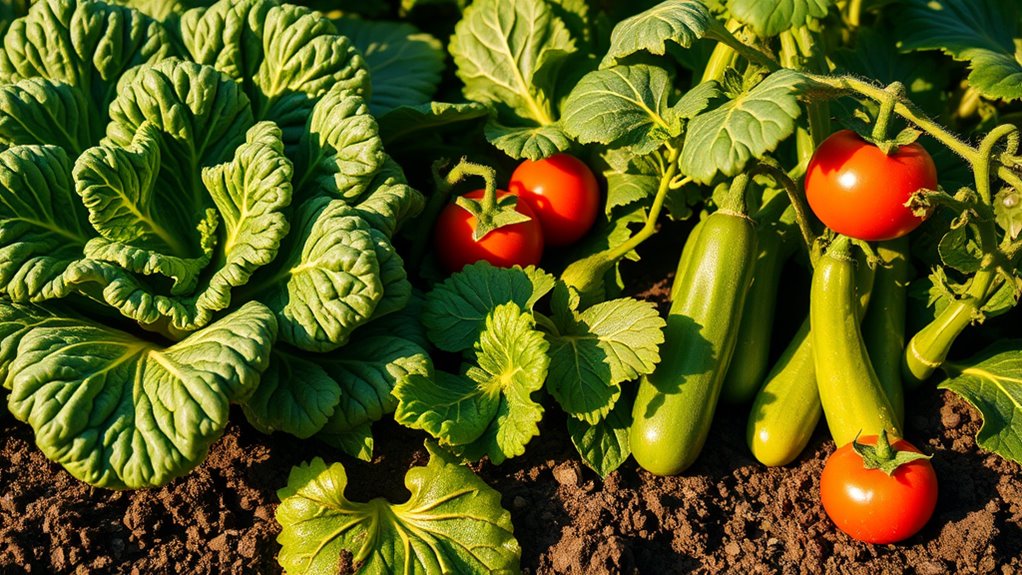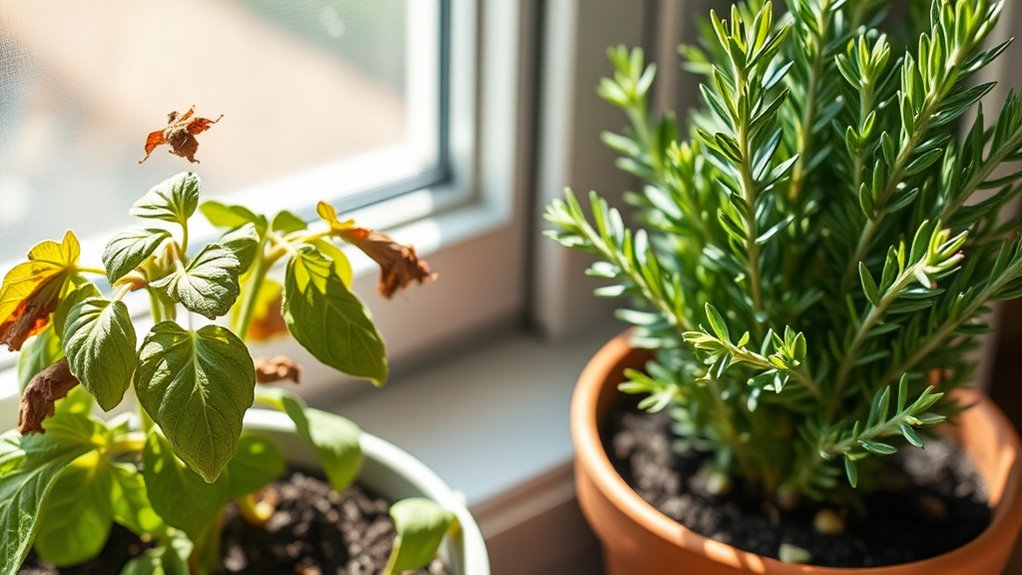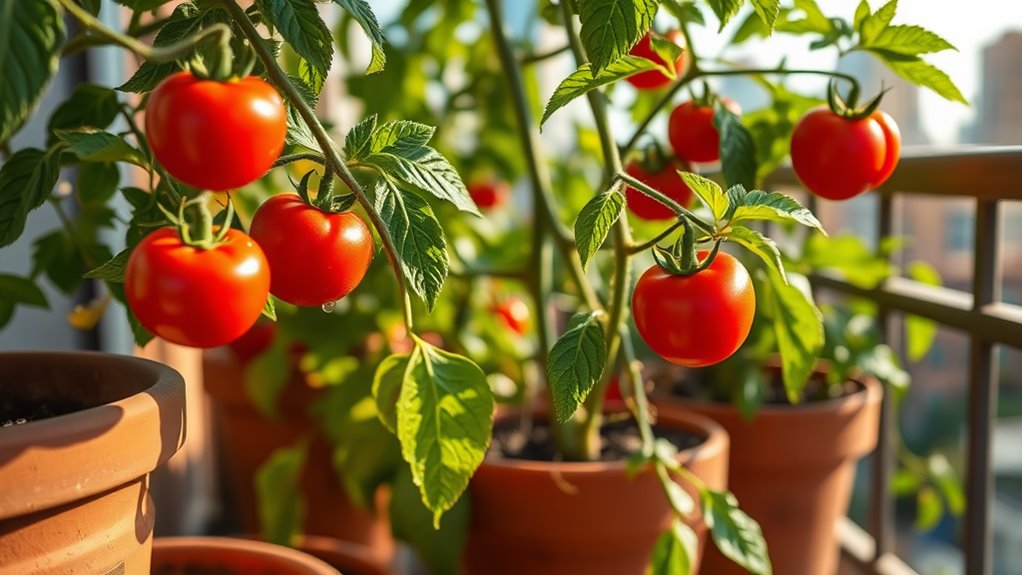I Grew 3 Times More Veggies Just By Doing This One Thing
You can triple your vegetable yields by mastering companion planting, where you pair plants like basil with tomatoes to naturally repel pests and enhance growth. It’s a scientifically backed method that boosts soil nutrients, reduces competition, and promotes healthier gardens with minimal effort. Start by testing your soil and choosing compatible veggies, and you’ll see results fast. Explore further techniques to maximize your harvest even more.
Key Takeaways
- Implement companion planting, like basil with tomatoes, to naturally repel pests and boost yields.
- Use organic compost to enrich soil nutrients, leading to healthier plants and increased production.
- Water plants in the early morning to reduce evaporation and ensure optimal hydration for growth.
- Rotate crops annually to prevent soil depletion and break pest cycles, enhancing overall output.
- Monitor soil pH regularly and adjust as needed to maximize nutrient uptake and vegetable growth.
The One Key Technique That Tripled My Yield
If you’re aiming to boost your vegetable yield, the one key technique that tripled mine is strategic companion planting.
This vegetable garden tip involves pairing plants like basil with tomatoes to repel pests naturally, as basil emits compounds that deter insects.
You enhance soil nutrients by interplanting beans with corn, where beans fix nitrogen for corn’s growth.
Scientifically, these combinations reduce competition for resources and boost pollination. Additionally, these strategies include plant pairings that thrive together for enhanced yields.
Practically, you plan your layout by grouping compatible veggies, rotating crops annually, and observing interactions to maximize space and harvest triple-fold.
Implement these tips for thriving gardens.
By incorporating specific plant combinations, you can also promote healthier gardens through enhanced growth and pest deterrence.
Essential Tools and Materials Needed
To grow more veggies effectively, you’ll start by identifying the basic tools like a trowel and gloves that make planting easier.
Next, gather key materials such as quality soil and compost to support healthy growth.
These essential supplies ensure your garden operates efficiently and yields better results.
Moreover, focusing on the three essential tools will help you achieve a thriving garden.
Additionally, incorporating must-have tools can significantly enhance your gardening success.
Basic Tools
Several essential tools will help you grow veggies efficiently, starting with a sturdy shovel for digging and a hand trowel for planting.
You’ll use these to minimize effort and prevent soil damage, ensuring precise work that boosts yields. Choose tools made from durable materials for longevity.
-
Gardening gloves: Protect your hands from blisters and thorns, allowing safer handling of plants and soil.
-
Hoe: Break up compacted earth effectively, promoting better root growth and weed control.
-
Watering can: Deliver water accurately to seedlings, reducing waste and preventing overwatering issues.
Key Materials
Key materials enhance your vegetable gardening efforts, building on basic tools to ensure success.
You’ll need high-quality seeds that are disease-resistant to boost germination rates and yield potential. Organic compost enriches soil with essential micronutrients, fostering beneficial microbial activity for healthier plants.
Mulch retains moisture, regulates soil temperature, and suppresses weeds, reducing labor and water loss. pH testing kits allow you to measure and adjust acidity precisely, optimizing nutrient uptake.
Drip irrigation systems deliver targeted watering, conserving resources while minimizing root stress. Integrating these practically maximizes your garden’s productivity scientifically.
Essential Supplies
As you expand your vegetable gardening setup, essential supplies like durable tools and targeted materials streamline your efforts and enhance yields.
These scientifically proven items boost efficiency, reduce labor, and optimize plant health for maximum production. By selecting high-quality supplies, you’ll apply practical techniques that triple your harvests.
-
Durable hand tools: Choose ergonomic pruners and trowels for precise cutting and digging, minimizing injury and effort.
-
Soil testing kits: Use these to measure pH and nutrients, allowing targeted amendments for healthier roots and higher yields.
-
Efficient irrigation systems: Install drip lines to deliver water directly to plants, conserving resources and preventing overwatering.
Step-by-Step Guide to Implementation
To implement your vegetable growing plan effectively, start by assessing your garden’s soil and resources, as this sets the foundation for success. Additionally, backyard solutions can be used to enhance soil quality with natural materials like leaves and compost.
Next, test soil pH and nutrient levels using a reliable kit, then amend as needed with organic matter for optimal fertility.
Select vegetable varieties suited to your conditions, planting them at the right depth and spacing for maximum yield.
Water consistently, aiming for even moisture without over-saturation, and monitor growth weekly.
Rotate crops scientifically to maintain soil health, ensuring a productive harvest cycle that boosts your output threefold.
Additionally, incorporate universal soil prep methods to ensure thriving plants across different environmental conditions.
Overcoming Common Gardening Hurdles
As you grow your veggies, you’ll face hurdles like beating garden pests, fixing soil problems, and managing water needs to keep your plants healthy.
For instance, soil testing can help identify and remedy soil issues to improve your garden’s health.
You can apply practical techniques based on scientific principles to address these challenges effectively.
Start by identifying specific issues in your garden and implementing targeted solutions for better yields.
By incorporating the gardening technique that tripled my vegetable yield, you can further boost your garden’s productivity.
Beating Garden Pests
Garden pests, such as aphids and caterpillars, can quickly damage your vegetable crops, but you’ll beat them by applying practical, science-backed techniques like integrated pest management.
This approach minimizes harm while maximizing yields through proactive monitoring and targeted actions.
-
Monitor regularly: Inspect plants weekly for pests, using tools like magnifying glasses to spot early infestations and track populations scientifically.
-
Encourage natural predators****: Attract beneficial insects, such as ladybugs or lacewings, by planting diverse flowers, fostering a balanced ecosystem that controls pests effectively.
-
Apply targeted treatments*: Use *organic options like insecticidal soaps when thresholds are reached, ensuring precise application to avoid resistance and environmental impact.
Fixing Soil Problems
Soil problems like poor drainage, nutrient deficiencies, and compaction can undermine your vegetable yields, but you’ll identify and fix them using straightforward, science-based techniques.
First, test your soil‘s pH and nutrient levels with a reliable kit; adjust pH by adding lime for acidity or sulfur for alkalinity. For nutrient shortages, incorporate compost or balanced fertilizers based on test results.
Combat compaction by aerating with a fork and mixing in organic matter to improve structure. Regularly monitor and amend to boost microbial activity, ensuring roots thrive and yields soar.
These steps make your garden resilient.
Managing Water Needs
Water management is crucial for your vegetable garden, as improper watering often leads to issues like wilting or root diseases.
You can optimize hydration by understanding your plants’ needs based on soil type, weather, and crop variety, ensuring efficient water use to promote healthy growth and higher yields.
-
Monitor soil moisture: Use a simple probe or finger test to water only when the top inch feels dry, preventing overwatering.
-
Implement mulching: Apply organic materials like straw to retain soil moisture and suppress weeds, reducing evaporation by up to 70%.
-
Time your watering: Water early morning or late evening to minimize loss from evaporation, delivering water directly to roots for better absorption.
Optimizing Soil and Plant Health
To thrive in your vegetable garden, you’ll first need to assess and enhance key elements like nutrient levels and pH balance, as these directly impact plant vitality.
Test your soil regularly using affordable kits to identify deficiencies, then amend it with organic compost or balanced fertilizers to boost nitrogen, phosphorus, and potassium.
Adjust pH by adding lime for acidic soils or sulfur for alkaline ones, promoting root health and nutrient uptake.
Incorporate cover crops to improve soil structure and microbial activity, reducing erosion and fostering disease resistance for robust, high-yielding plants.
Embrace natural soil preparation to significantly enhance your harvest without relying on fertilizers.
Stay vigilant against pests with natural predators and rotations.
By prioritizing soil testing, you can enhance plant health, boost crop yields, and avoid expensive gardening errors.
Measuring and Tracking Your Progress
Once you’ve optimized your soil and plant health, you’ll track your garden’s progress to ensure improvements pay off.
Monitoring helps you spot trends, adjust strategies, and maximize yields scientifically. Additionally, integrating watering techniques can further enhance plant hydration and support overall garden vitality.
To ensure your tracking is effective, begin by assessing soil health as one of the key preparation steps for a thriving garden.
-
Measure yields weekly: Weigh your harvested veggies to quantify growth rates and compare against baselines for data-driven insights.
-
Track plant metrics: Regularly record height, leaf count, and health indicators like color or pest damage using simple tools like rulers and journals.
-
Log environmental factors: Note soil pH, moisture levels, and weather data to correlate variables with performance, enabling precise tweaks.
Advanced Tips for Even Greater Results
Building on your tracking efforts, you’ll unlock advanced techniques that amplify your garden’s productivity through targeted innovations in soil enhancement, pest management, and yield optimization. Focus on compost teas for nutrient-rich soil, introducing beneficial insects for natural pest control, and precise pruning to boost yields.
| Technique | Benefit |
|---|---|
| Compost Tea Application | Enhances microbial activity, improving nutrient uptake |
| Beneficial Insects | Reduces chemical use, maintaining ecological balance |
| Strategic Pruning | Increases airflow, minimizing disease and maximizing fruit |
| Mulching Techniques | Retains moisture, suppressing weeds effectively |
| Crop Rotation | Prevents soil depletion, reducing pest cycles |





